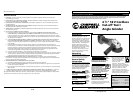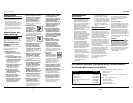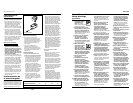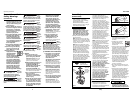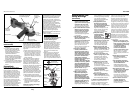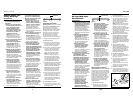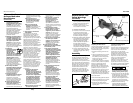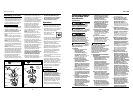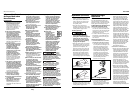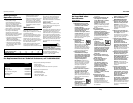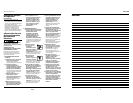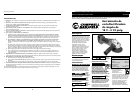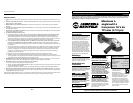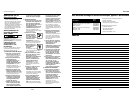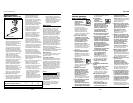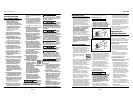
3
DG472500DI
e) Do not overreach.
Keep proper footing
and balance at all
times. This enables
better control of the power tool
inunexpected situations.
f)Dress properly. Do not wear
loose clothing or jewelry. Keep
your hair, clothing and gloves
away from moving parts. Loose
clothes, jewelry or long hair can be
caught in moving parts.
g)If devices are provided for
the connection of dust
extraction and collection
facilities, ensure these are
connected and properly used.
Use of dust collection can reduce
dust-related hazards.
h)Some wood contains
preservatives which
can be toxic. Take
extra care to prevent
inhalation and skin contact
when working with these
materials. Request and follow
all safety information available
from your material supplier.
i)Do not put hands near
moving parts.
j)Do not misuse this product.
Excessive exposure to
vibration, work in awkward
positions, and repetitive work
motions can cause injury to
hands and arms. Stop using
any tool if discomfort,
numbness, tingling, or pain
occur, and consult a physician.
k) Ensure the switch is in the off
position before inserting the
battery pack. Inserting the battery
pack into power tools that have the
switch on invites accidents.
l) Do not incinerate the battery
pack as it may explode in a fire.
4) POWER TOOL USE AND CARE
a)Do not force the power tool.
Use the correct power tool
for your application. The
correct power tool will do the
job better and safer at the rate
for which it was designed.
b)Do not use the power tool if
the switch does not turn it on
and off. Any power tool that
cannot be controlled with the
switch is dangerous and must be
repaired.
c) Disconnect the plug from the
power source and/or the
battery pack from the power
tool before making any
adjustments, changing
accessories, or storing power
tools. Such preventive safety
measures reduce the risk of starting
the power tool accidentally.
d)Store idle power tools out of
the reach of children and do
not allow persons unfamiliar
with the power tool or these
instructions to operate the
power tool. Power tools are
dangerous in the hands of
untrained users.
e) Maintain power tools. Check for
misalignment or binding of
moving parts, breakage of parts
and any other condition that
may affect the power tool’s
operation. If damaged, have the
power tool repaired before use.
Many accidents are caused by
poorly maintained power tools.
f)Keep cutting tools sharp and
clean. Properly maintained
cutting tools with sharp cutting
edges are less likely to bind and
are easier to control.
g)Use the power tool, accessories
and tool bits etc. in accordance
with these instructions, taking
into account the working
conditions and the work to be
performed. Use of the power tool
for operations different from those
intended could result in a
hazardous situation.
h)When the battery pack is not
in use, keep it away from
metal objects such as paper
clips, coins, keys, nails, screws,
or the like so there is no risk
of the battery terminals being
connected (that is, “shorted”)
together. Shorting the battery
terminals together may cause
sparks, burns, a fire, a shock, or
damage to the battery.
i)Always use the side (auxiliary)
handle when working with
this tool. Make sure that the
handle is securely tightened
against the metal gear
housing prior to turning the
tool on. The auxiliary handle
provides much greater control
when operating this tool.
j)Grip the tool securely with
both hands while performing
the work.
k)Do not use damaged or warn
attachments.
l)Always use the guard, that is,
never remove it from the tool.
The guard protects the operator
from broken disc fragments.
m)Make sure that the guard is
in good condition and
securely installed before
operating the tool.
n)Never point the tool at
oneself or any other person.
Serious injury could occur.
o)Do not clamp the tool in a
vise or use as a fixed cut-off
tool/grinder.
p)Do not install a woodcarving
blade on this tool.
q)This tool may NOT be
modified or used for any
application other than that
for which it was designed.
r)The working disc and guard
must be securely attached (as
described in this operating
manual) before connecting
the tool to the battery pack.
s)Never turn on the grinder with
the disc or any rotating parts
touching the workpiece.
t) Use steady, even pressure
when using this tool. Do not
force. Too much pressure can
cause the disc to break or overheat.
u)Never place the tool on the
floor or other surface while it
is running. The disc continues
to rotate after the tool is
switched off.
v)Use this tool only with the
supplied battery pack or the
recommended replacement
pack as specified by the
manufacturer. Use of any other
battery packs may create a risk
of injury or fire.
General Power Tool
Safety Warnings
(Continued)
Manual de Instrucciones
34 Sp
• Carga inicial
Antes de usar la herramienta por
primera vez, cargue la batería por
completo. Para hacer esto enchufe
primero el cargador de la batería en
un suministro de corriente de 120V
(60 Hz) e introduzca la batería
totalmente dentro del cargador,
prestando atención a que la saliente
de la batería quede orientada de
modo que calce en la muesca del
cargador de la batería. Cuando se
presiona suavemente la batería para
que la misma toque el fondo del
cargador, la luz verde de “OFF”
(apagado) del cargador debería
iluminarse. Luego presione el botón
“SET” (ajustar) y cuando lo haya
hecho, la luz roja “ON” (encendido)
de carga debería encenderse en
lugar de la luz verde “OFF”. Esta luz
roja indica que ha comenzado la
secuencia de carga y la batería no se
debe quitar hasta que la carga se
haya completado. Cuando la batería
esté totalmente cargada, la luz roja
“ON” debería apagarse y en ese
momento debería encenderse la luz
verde “OFF”. Este proceso de carga
debería llevar aproximadamente
una hora.
• NOTAS ADICIONALES SOBRE
LA CARGA
• Durante el uso normal, la batería
perderá eventualmente su
capacidad y cuando esto suceda,
habrá una diferencia notoria en el
rendimiento de la herramienta.
Es en este momento que la batería
está casi descargada y debe volver a
cargarse. Si la batería está tibia o
caliente al tacto, deje que se enfríe
antes de colocarla en el cargador.
Esto permitirá que la batería acepte
una carga completa mientras que
no podrá hacerlo si se introduce en
el cargador mientras tiene una
temperatura elevada.
• Con el tipo de batería
proporcionada con este
herramienta, es decir del tipo Ni-Cd
o níquel-cadmio, es mejor cargar la
batería cuando está casi totalmente
descargada. Este es el momento en
el que hay una diferencia notoria en
el rendimiento de la herramienta. Si
se coloca la batería en el cargador
presiones laterales ejercidas
cuando se rectifica una superficie.
• Con el disco de corte sin tocar la
pieza de trabajo, deje que llegue a la
velocidad máxima y luego aplique
una presión mínima a la pieza de
trabajo. La velocidad de corte
óptima es cuando el disco de trabajo
se encuentra a su máxima velocidad.
• Una vez que se haya comenzado el
corte y se haya formado la muesca,
continúe cortando al mismo ángulo
hasta llevar a cabo el corte deseado.
Cambiar el ángulo del disco hará que
la rueda se doble o se pueda quebrar.
• Una vez completada la operación de
corte, retire la herramienta de la
pieza de trabajo y espere a que la
herramienta deje de girar antes
dejarla a un lado.
Operación de rectificado
• No use discos de corte para
operaciones de rectificado de
superficie. Los discos de corte no
están diseñados para soportar las
presiones laterales ejercidas
cuando se rectifica una superficie.
También pueden tender a ranurar
en la pieza de trabajo.
• Con el disco de rectificado sin tocar
la pieza de trabajo, deje que llegue a
la velocidad máxima y luego aplique
una presión mínima a la pieza de
trabajo. La velocidad de rectificado
óptima es cuando el disco de trabajo
se encuentra a su máxima velocidad.
• Mientras mantiene un ángulo de 10°
a 20° entre la pieza de trabajo y la
herramienta, mueva continuamente
la herramienta de adelante hacia
atrás para evitar crear ranuras en la
pieza de trabajo.
• Una vez completada la operación de
rectificado, retire la herramienta de
la pieza de trabajo y espere a que la
herramienta deje de girar antes
dejarla a un lado.
Funcionamiento de
la batería/cargador
La fuente de energía de este
herramienta proviene de las baterías
que se proporcionan. Es importante que
el usuario comprenda lo siguiente a fin
de obtener el mayor rendimiento de la
batería y del cargador de la batería.
Instalación / Remoción de la
batería de la herramienta
• Para instalar la batería en la
herramienta, introduzca la porción
protuberante de la batería dentro
del mango la herramienta. Empuje la
batería hasta que escuche que la
misma queda enganchada en la
herramienta.
• Para retirar la batería de la
herramienta, presione los dos
botones circulares (estriados) que se
encuentran en la batería y luego tire
de la batería para separarla de la
herramienta.
Carga de la batería
• INSTALACIÓN / REMOCIÓN DE LA
BATERÍA DEL CARGADOR DE BATERÍA
• La batería está diseñada para que
únicamente calce en el cargador en
una sola orientación, por lo tanto,
no hay ningún motivo para forzar
la batería dentro del cargador.
Para instalar la batería en el
cargador, introduzca la parte
protuberante de la batería dentro
del cargador. La saliente en uno de
los lados de la batería debe quedar
alineada con la muesca en el
cargador de la batería. Una vez que
se realiza esta alineación, empuje
suavemente la batería hasta que
toque el fondo en el cargador.
• Para retirar la batería del
cargador, simplemente tire de la
batería en dirección vertical hacia
afuera del cargador de la batería
mientras sostiene al cargador con
la otra mano.
Cargador y Batería
Largo del cable en pies 25 50 100 150
Tamaño AWG del cable 18 18 18 16
Tamaño mínimo del cable (AWG) de extensión para el cargador de batería
Funcionamiento
(Continuación)



